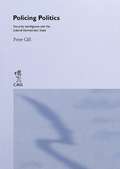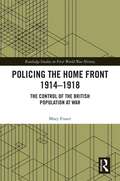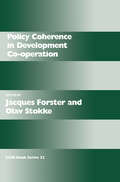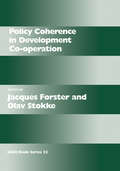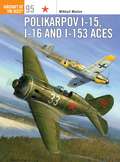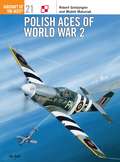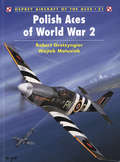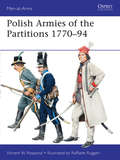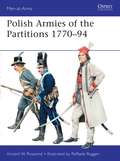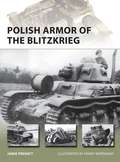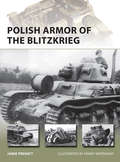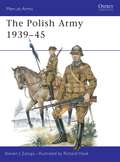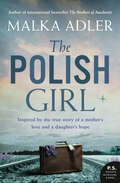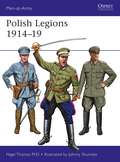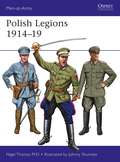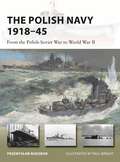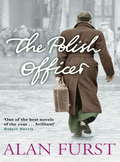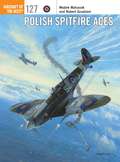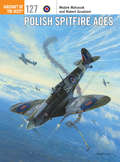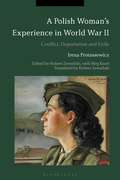- Table View
- List View
Policing Politics: Security Intelligence and the Liberal Democratic State (Studies in Intelligence)
by Peter GillNumerous allegations of abuse of power have been made against the domestic security intelligence agencies in the United Kingdom such as police special branches and MI5. These include the improper surveillance of trade unionists and peace activists, campaigns of mis-information against elected politicians and even the elimination' of people believed to be engaged in political violence. Drawing on extensive foreign material and making use of the social science concepts of information, power and law, this book develops a framework for the comparative analysis of these agencies.
Policing Politics: Security Intelligence and the Liberal Democratic State (Studies in Intelligence)
by Peter GillNumerous allegations of abuse of power have been made against the domestic security intelligence agencies in the United Kingdom such as police special branches and MI5. These include the improper surveillance of trade unionists and peace activists, campaigns of mis-information against elected politicians and even the elimination' of people believed to be engaged in political violence. Drawing on extensive foreign material and making use of the social science concepts of information, power and law, this book develops a framework for the comparative analysis of these agencies.
Policing the Home Front 1914-1918: The control of the British population at war (Routledge Studies in First World War History)
by Mary FraserThe civilian police during the First World War in Great Britain were central to the control of the population at home. This book will show the detail and challenges of police work during the First World War and how this impacted on ordinary people’s daily lives. The aim is to tell the story of the police as they saw themselves through the pages of their best-known journal, The Police Review and Parade Gossip, in addition to a wide range of other published, archival and private sources.
Policing the Home Front 1914-1918: The control of the British population at war (Routledge Studies in First World War History)
by Mary FraserThe civilian police during the First World War in Great Britain were central to the control of the population at home. This book will show the detail and challenges of police work during the First World War and how this impacted on ordinary people’s daily lives. The aim is to tell the story of the police as they saw themselves through the pages of their best-known journal, The Police Review and Parade Gossip, in addition to a wide range of other published, archival and private sources.
Policy Coherence in Development Co-operation (Routledge Research EADI Studies in Development #8)
by Jacques Forster Olav StokkeIn the 1990s, a shared conviction emerged among aid donors that their policies should be more coherent. The drive towards increased policy coherence came as a response to a state of policy incoherence. The shifting grounds of policy coherence in development co-operation are outlined in this volume.
Policy Coherence in Development Co-operation (Routledge Research EADI Studies in Development)
by Jacques Forster Olav Schram StokkeIn the 1990s, a shared conviction emerged among aid donors that their policies should be more coherent. The drive towards increased policy coherence came as a response to a state of policy incoherence. The shifting grounds of policy coherence in development co-operation are outlined in this volume.
Polikarpov I-15, I-16 and I-153 Aces (Aircraft of the Aces #95)
by Mikhail Maslov Mr Mark PostlethwaiteThe I-15, I-16 and I-153 fighters were the world's first mass-produced fighters. Some 17,000 Polikarpovs had been manufactured by the time production ceased in 1941. They served with the Republicans in the Spain, the Chinese against Japan in 1937–38, and the Soviets against both Japan in the Nomonhan Incident and Finland during the Winter War. By 1941, more than 20 Soviet pilots had made ace in Polikarpovs, and many more attained that status during the first months of the German invasion. Though thoroughly outclassed, the Polikarpov was the backbone of the Soviet air force during the early months of the war in the east, and continued to serve, as training aircraft and as frontline fighters, some right through to 1945.
Polikarpov I-15, I-16 and I-153 Aces (Aircraft of the Aces)
by Mark Postlethwaite Mikhail MaslovThe I-15, I-16 and I-153 fighters were the world's first mass-produced fighters. Some 17,000 Polikarpovs had been manufactured by the time production ceased in 1941. They served with the Republicans in the Spain, the Chinese against Japan in 1937–38, and the Soviets against both Japan in the Nomonhan Incident and Finland during the Winter War. By 1941, more than 20 Soviet pilots had made ace in Polikarpovs, and many more attained that status during the first months of the German invasion. Though thoroughly outclassed, the Polikarpov was the backbone of the Soviet air force during the early months of the war in the east, and continued to serve, as training aircraft and as frontline fighters, some right through to 1945.
Polish Aces of World War 2 (Aircraft of the Aces)
by Robert GretzyngierPilots of the Polish Air Force saw action from the first day of World War 2 until the final victory in Europe. Flying hopelessly outmoded P.11 fighters in defence of their country in September 1939, a handful of aviators inflicted serious losses on the Luftwaffe before being overwhelmed. The survivors escaped to then neutral Hungary and Romania, before being ordered to France by the new C-in-C of exiled Polish Armed Forces, General Sikorski. With the invasion of Western Europe in May 1940, the surviving pilots were once more thrust into desperate action in newly-formed Polish units
Polish Aces of World War 2 (Aircraft of the Aces)
by Robert GretzyngierPilots of the Polish Air Force saw action from the first day of World War 2 until the final victory in Europe. Flying hopelessly outmoded P.11 fighters in defence of their country in September 1939, a handful of aviators inflicted serious losses on the Luftwaffe before being overwhelmed. The survivors escaped to then neutral Hungary and Romania, before being ordered to France by the new C-in-C of exiled Polish Armed Forces, General Sikorski. With the invasion of Western Europe in May 1940, the surviving pilots were once more thrust into desperate action in newly-formed Polish units
Polish Armies of the Partitions 1770–94 (Men-at-Arms #485)
by Vincent W. Rospond Mr Raffaele RuggeriThe tragic national epic of Polish history began in these late 18th-century wars. Under Poland's Saxon monarchy, Russia and Prussia constantly meddled in the affairs of the Kingdom. In 1768 a civil war broke out between pro-Russian 'Commonwealth' Poles and 'Confederate' patriots who opposed foreign intervention; Russia intervened directly, and the First Partition followed in 1772. Guerrilla resistance continued, and anti-Russian political moves were snuffed out by a second Russian invasion in 1792. Following a Second Partition between Russia and Prussia in 1793, Poland's national hero Thaddeus Kosciusko led a national uprising against the invaders in April 1794. After remarkable victories against the odds at Raclawice and Warsaw, the patriots were finally defeated by the combined armies of Prussia and Russia at Maciejowice. This led to the Third Partition of 1795, between Prussia, Russia, and Austria, and Poland ceased to exist as a political nation. Featuring specially commissioned full-color illustrations, this is the epic story of Poland's doomed struggle to remain independent in the face of aggression from its neighbours in the late 18th century.
Polish Armies of the Partitions 1770–94 (Men-at-Arms #485)
by Raffaele Ruggeri Vincent W. RospondThe tragic national epic of Polish history began in these late 18th-century wars. Under Poland's Saxon monarchy, Russia and Prussia constantly meddled in the affairs of the Kingdom. In 1768 a civil war broke out between pro-Russian 'Commonwealth' Poles and 'Confederate' patriots who opposed foreign intervention; Russia intervened directly, and the First Partition followed in 1772. Guerrilla resistance continued, and anti-Russian political moves were snuffed out by a second Russian invasion in 1792. Following a Second Partition between Russia and Prussia in 1793, Poland's national hero Thaddeus Kosciusko led a national uprising against the invaders in April 1794. After remarkable victories against the odds at Raclawice and Warsaw, the patriots were finally defeated by the combined armies of Prussia and Russia at Maciejowice. This led to the Third Partition of 1795, between Prussia, Russia, and Austria, and Poland ceased to exist as a political nation. Featuring specially commissioned full-color illustrations, this is the epic story of Poland's doomed struggle to remain independent in the face of aggression from its neighbours in the late 18th century.
Polish Armor of the Blitzkrieg (New Vanguard)
by Henry Morshead Jamie PrenattThe Polish army during the Blitzkrieg conjures up tragic images of infantry and dashing, but ineffective and ultimately doomed cavalry charges. In actuality the Poles, in the midst of a large-scale re-armament programme, had up to 600 armoured vehicles available at the time of the German attack, as well as a number of newer and better designs in various stages of development. Facing the inventors of the 'Lightning War', who attacked in great numbers, on multiple fronts and with total mastery of the air, the Polish armoured formations were up against it. But outdated equipment, doctrine and enormous odds did not stop these units from fighting with bravery and determination before being finally overwhelmed. This volume is a complete technical study of the machines that formed the backbone of Poland's defences on the ground, using never-before-seen photographs and a comprehensive design and developmental history that reveal a full picture of Poland's armoured forces in the context of their greatest challenge.
Polish Armor of the Blitzkrieg (New Vanguard #224)
by Jamie Prenatt Mr Henry MorsheadThe Polish army during the Blitzkrieg conjures up tragic images of infantry and dashing, but ineffective and ultimately doomed cavalry charges. In actuality the Poles, in the midst of a large-scale re-armament programme, had up to 600 armoured vehicles available at the time of the German attack, as well as a number of newer and better designs in various stages of development. Facing the inventors of the 'Lightning War', who attacked in great numbers, on multiple fronts and with total mastery of the air, the Polish armoured formations were up against it. But outdated equipment, doctrine and enormous odds did not stop these units from fighting with bravery and determination before being finally overwhelmed. This volume is a complete technical study of the machines that formed the backbone of Poland's defences on the ground, using never-before-seen photographs and a comprehensive design and developmental history that reveal a full picture of Poland's armoured forces in the context of their greatest challenge.
The Polish Army 1939–45 (Men-at-Arms #117)
by Steven J. Zaloga Richard HookPoland was the first of the Allied nations to succumb to German aggression in the Second World War, but by the most tortuous of routes her army managed to remain in the field through all five years of bloody fighting. Polish soldiers fought in nearly every major campaign in the European theatre, and their tale is a complicated and tragic one. This richly detailed text by Steven Zaloga relates the story of the Polish Army during the Second World War, from the first wave of Stukas in 1939 to its eventual conclusion.
The Polish Army 1939–45 (Men-at-Arms #117)
by Steven J. Zaloga Richard HookPoland was the first of the Allied nations to succumb to German aggression in the Second World War, but by the most tortuous of routes her army managed to remain in the field through all five years of bloody fighting. Polish soldiers fought in nearly every major campaign in the European theatre, and their tale is a complicated and tragic one. This richly detailed text by Steven Zaloga relates the story of the Polish Army during the Second World War, from the first wave of Stukas in 1939 to its eventual conclusion.
The Polish Girl
by Malka AdlerIn the eye of the war That tore the world apart A mother wants a son A daughter needs a mother
Polish Legions 1914–19 (Men-at-Arms #518)
by Johnny Shumate Nigel ThomasDue to its partitions and dissolution in the late eighteenth century, hundreds of thousands of Polish soldiers enlisted in distinct units in the armies of many countries – primarily those of the Russian and Austro-Hungarian empires, but also that of the German Reich and the French Republic.All these forces were uniformed and equipped by the parent armies, though often with explicitly Polish features. The collapse of Tsarist Russia in 1917 and of the Central Powers in 1918 allowed these diverse forces to unite in a re-created Polish Army under the new-born Second Polish Republic in November 1918. With full colour illustrations of their unique and colourful uniforms as well as contemporary photographs, this is the fascinating story of the Poles who fought on both sides of the trenches in World War I and then united to fight for their freedom in the Russian Civil War.
Polish Legions 1914–19 (Men-at-Arms #518)
by Johnny Shumate Nigel ThomasDue to its partitions and dissolution in the late eighteenth century, hundreds of thousands of Polish soldiers enlisted in distinct units in the armies of many countries – primarily those of the Russian and Austro-Hungarian empires, but also that of the German Reich and the French Republic.All these forces were uniformed and equipped by the parent armies, though often with explicitly Polish features. The collapse of Tsarist Russia in 1917 and of the Central Powers in 1918 allowed these diverse forces to unite in a re-created Polish Army under the new-born Second Polish Republic in November 1918. With full colour illustrations of their unique and colourful uniforms as well as contemporary photographs, this is the fascinating story of the Poles who fought on both sides of the trenches in World War I and then united to fight for their freedom in the Russian Civil War.
The Polish Navy 1918–45: From the Polish-Soviet War to World War II (New Vanguard)
by Przemyslaw BudzbonPacked with illustrations, this is a study of the Polish warships such as the Grom-class destroyers that were developed and built in the interwar years.Newly independent Poland's naval force was created in 1920, initially with six ex-German torpedo boats. However, after German-Soviet exercises off the Polish coast in 1924, funding for warships was hastily allocated. Two destroyers and three submarines were built in France but, disappointed with their quality, Poland ordered new ships, mostly from British and Dutch shipyards. By summer 1939, the Polish Navy comprised four destroyers, five submarines, one minelayer, six minesweepers and a handful of lesser ships. Although the Grom-class destroyers were two of the fastest and best-armed destroyers of the war, the tiny Polish fleet would stand little chance against the Kriegsmarine, and on 30 August three destroyers were dispatched to Britain, followed by two submarines that escaped internment. The remaining Polish surface fleet was sunk by 3 September. In exile, the Polish Navy operated not only their own ships, but also Royal Navy warships, including a cruiser, destroyers, submarines and motor torpedo boats which fought alongside the Allies in the Battle of the Atlantic, the Arctic Convoys, and at the Normandy landings. This detailed account not only describes the Polish Navy's contribution to the Allied war effort but also the episode of the Polish destroyer Piorun which took on the Bismarck in a lone gun duel leading to the sinking of the great German battleship.
The Polish Navy 1918–45: From the Polish-Soviet War to World War II (New Vanguard)
by Przemyslaw BudzbonPacked with illustrations, this is a study of the Polish warships such as the Grom-class destroyers that were developed and built in the interwar years.Newly independent Poland's naval force was created in 1920, initially with six ex-German torpedo boats. However, after German-Soviet exercises off the Polish coast in 1924, funding for warships was hastily allocated. Two destroyers and three submarines were built in France but, disappointed with their quality, Poland ordered new ships, mostly from British and Dutch shipyards. By summer 1939, the Polish Navy comprised four destroyers, five submarines, one minelayer, six minesweepers and a handful of lesser ships. Although the Grom-class destroyers were two of the fastest and best-armed destroyers of the war, the tiny Polish fleet would stand little chance against the Kriegsmarine, and on 30 August three destroyers were dispatched to Britain, followed by two submarines that escaped internment. The remaining Polish surface fleet was sunk by 3 September. In exile, the Polish Navy operated not only their own ships, but also Royal Navy warships, including a cruiser, destroyers, submarines and motor torpedo boats which fought alongside the Allies in the Battle of the Atlantic, the Arctic Convoys, and at the Normandy landings. This detailed account not only describes the Polish Navy's contribution to the Allied war effort but also the episode of the Polish destroyer Piorun which took on the Bismarck in a lone gun duel leading to the sinking of the great German battleship.
The Polish Officer
by Alan FurstFrom the master of the historical spy thriller, a story set in the heart of the Polish resistanceSeptember, 1939. The invading Germans blaze a trail of destruction across Poland. France and Britain declare war, but do nothing to help. And a Polish resistance movement takes shape under the shadow of occupation, enlisting those willing to risk death in the struggle for their nation's survival. Among them is Captain Alexander de Milja, an officer in the Polish military intelligence service, a cartographer who now must learn a dangerous new role: spymaster in the anti-Nazi underground. Beginning with a daring operation to smuggle the Polish National Gold Reserve to the government in exile, he slips into the shadowy and treacherous front lines of espionage; he moves through Europe, changing identities and staying one step ahead of capture. In Warsaw, he engineers a subversive campaign to strengthen the people's will to resist. In Paris, he poses as a Russian poet, then as a Slovakian coal merchant, drinking champagne in black-market bistros with Nazis while uncovering information about German battle plans. And a love affair with a woman of the French Resistance leads him to make the greatest decision of his life.
Polish Spitfire Aces (Aircraft of the Aces)
by Wojtek Matusiak Robert GrudzienOf all Allied airmen, Polish pilots had had the most experience of fighting the Luftwaffe by the time the war came to Britain. As the Battle of Britain raged, they quickly proved themselves as highly aggressive and skilful interceptors, especially when flying the famous Spitfire. The Polish Air Force eventually became the largest non-Commonwealth Spitfire operator, using some 1,500 Mks I, II, V, IX and XVI to devastating effect. Top scoring USAAF ace of the ETO, Francis "Gabby" Gabreski and a whole host of other Allied and Commonwealth aces flew with Polish squadrons, adding even more to their fighting quality. Conversely, several Polish pilots were attached to other Allied squadrons throughout the war, demonstrating their prowess alongside airmen from a whole host of nations. From an expert on Polish fighter aviation, this is a peerless account of the fiery, talented Polish "Spit" pilots, whose country had been overrun and whose aggression and determination to shoot down Axis aircraft was unmatched.
Polish Spitfire Aces (Aircraft of the Aces #124)
by Wojtek Matusiak Robert GrudzienOf all Allied airmen, Polish pilots had had the most experience of fighting the Luftwaffe by the time the war came to Britain. As the Battle of Britain raged, they quickly proved themselves as highly aggressive and skilful interceptors, especially when flying the famous Spitfire. The Polish Air Force eventually became the largest non-Commonwealth Spitfire operator, using some 1,500 Mks I, II, V, IX and XVI to devastating effect. Top scoring USAAF ace of the ETO, Francis "Gabby" Gabreski and a whole host of other Allied and Commonwealth aces flew with Polish squadrons, adding even more to their fighting quality. Conversely, several Polish pilots were attached to other Allied squadrons throughout the war, demonstrating their prowess alongside airmen from a whole host of nations. From an expert on Polish fighter aviation, this is a peerless account of the fiery, talented Polish "Spit" pilots, whose country had been overrun and whose aggression and determination to shoot down Axis aircraft was unmatched.
A Polish Woman’s Experience in World War II: Conflict, Deportation and Exile
by Meg Knott Hubert Zawadzki Irena ProtassewiczThis hitherto unpublished first-hand witness account, written in 1968-9, tells the story of a privileged Polish woman whose life was torn apart by the outbreak of the Second World War and Soviet occupation. The account has been translated into English from the original Polish and interwoven with letters and depositions, and is supplemented with commentary and notes for invaluable historical context. Irena Protassewicz's vivid account begins with the Russian Revolution, followed by a rare insight into the life and mores of the landed gentry of northeastern Poland between the wars, a rural idyll which was to be shattered forever by the coming of the Second World War. Deported in a cattle truck to Siberia and sentenced to a future of forced labour, Irena's fortunes were to change dramatically after Hitler's attack on Russia. She charts the adventure and horror of life as a military nurse with the Polish Army, on a journey that would take her from the wastes of Soviet Central Asia, through the Middle East, to an unlikely ending in the highlands of Scotland. The story concludes with Irena's search to discover the wartime and post-war fate of her family and friends on both sides of the Iron Curtain, and the challenges of life as a refugee in Britain. A Polish Woman's Experience in World War II provides a compelling, personal route into understanding how the greatest conflict of the 20th century transformed the lives of the individuals who lived through it.
